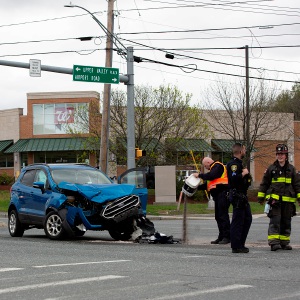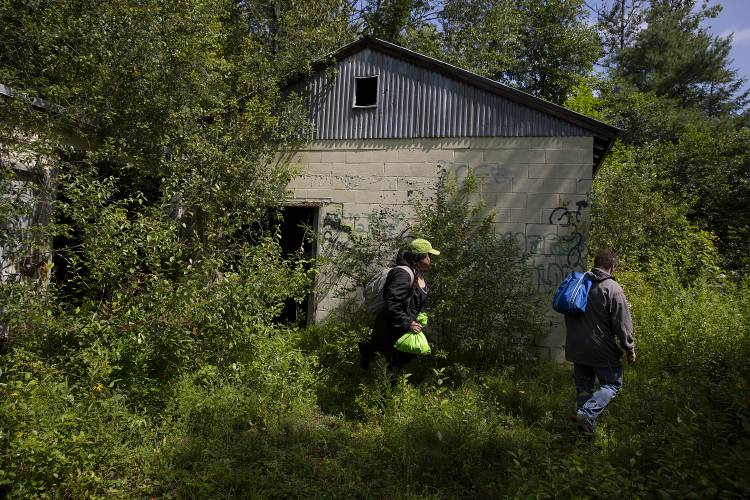Lebanon homeless count finds 41 people camping or living out of cars, up since hotel vouchers ended
| Published: 08-12-2023 10:50 PM |
LEBANON — A count conducted last week by Lebanon’s regional Housing First committee and volunteers found 50 people without permanent homes.
Of those, 41 are unsheltered, camping or living in vehicles, and 33 of those who are unsheltered are living in New Hampshire. This marks an uptick from 16 unsheltered people recorded during a count this winter before the New Hampshire Emergency Rental Assistance Program ended.
The count, spearheaded by Lebanon Assistant Human Services Director Rebecca Desilets and Sophia Gawel, service coordinator for Listen Community Services, involved meeting with homeless people where they were living, as well as with people who identified themselves as homeless while receiving services in Listen’s food pantry and community dinner hall.
“Many people who we spoke with during the daytime were unsure of where they would sleep or rest that night,” Gawel said. “These individuals shared that locations which feel safe or feasible for camping often change daily.”
The count, conducted Thursday, Aug. 3, through Saturday, Aug. 5, found fewer people than the city’s annual count in January, which found 85 people living in Lebanon, a city of about 15,000, without homes. But a higher percentage of those counted last week were living without shelter.
The count conducted in Lebanon on Jan. 25 found 85 people in the city lacked permanent places to stay, according to a Human Services report presented to the City Council in May.
Of those, 62 were living in a hotel room, 16 were living in a place not intended for human habitation, five people were couch surfing and two were sheltered but “imminently homeless.”
Of those living in hotels in January, 69% were funded by the ERAP program, which has since ended.
Article continues after...
Yesterday's Most Read Articles
 Homeless Upper Valley couple faces ‘a very tough situation’
Homeless Upper Valley couple faces ‘a very tough situation’
 Lebanon’s Jewell back from auto accident, more aware of ‘drowsy driving’ dangers
Lebanon’s Jewell back from auto accident, more aware of ‘drowsy driving’ dangers
 Plan on track to ship Upper Valley mail to Connecticut for sorting
Plan on track to ship Upper Valley mail to Connecticut for sorting
 West Lebanon crash
West Lebanon crash
 Crane crash on Interstate 89
Crane crash on Interstate 89
Gawel said the end of the program has left more people unsheltered in the city.
She also suspects some people who were living in Lebanon motels have moved away since the program ended.
Later this week and into next week, a team of volunteers will be conducting additional outreach in Grafton, Canaan and Enfield, Gawel said.
It’s valuable to collect numbers at different times of year because the needs and groups change with the season, she said. While summer counts have taken place in previous years, it’s not a regular occurrence. The count comes amid a housing shortage and high housing costs. Currently there are no shelters in Lebanon.
The nearest are in White River Junction and Claremont. To fill that gap, the city is making efforts to establish a seasonal shelter, and the White River Junction-based Upper Valley Haven continues to develop a plan for a low-barrier shelter.
“The city is evaluating the potential for a 15-bed seasonal shelter on a city-owned property,” Lebanon Human Services Director Lynne Goodwin said in an email. “This project — if it proceeds — will partially address temporary housing for unhoused individuals but will not solve the problem of homelessness.”
Deputy City Manager David Brooks said the city is working on plans to transform a property located at 160 Mechanic Street into a temporary seasonal shelter, but it’s still sorting out what improvements are necessary, what it will cost and how the city will pay for it.
“The need is unquestionably there,” he said. “No reason to think it’s going to go away. (It’s) going to get cold again.”
The Haven has not yet filed a formal proposal to use the former 25,000 Gifts & Woolens store building, located on North Main Street in White River Junction, as a low-barrier shelter for people who may be struggling with substance use, Michael Redmond, executive director of the Upper Valley Haven, said in Thursday email.
“We are working with Lynne Goodwin on ideas to address homelessness in Lebanon for this winter,” he said.
To conduct last week’s count, the organizers used information from previous efforts, as well as information from the city and the police department, to create a map of where people without homes might be likely to be. Amid this year’s flooding, some sites where people typically camp in the summertime have been abandoned, forcing people to find new locations and sometimes to find new camping gear, Gawel said.
It adds up to “a lot of instability” for people,” she said.
The count’s organizers invited volunteers to sign up for shifts.
Two-person teams signed up for each shift and location. Volunteers participated in a training session via Zoom held in advance. During the count, they were equipped with incentive bags, including the overdose reversal drug naloxone, also known by the brand name Narcan; tick removers; toiletries and nonperishable food items, to hand out to people who were counted.
In addition to asking people whether they were housed, volunteers also asked for demographic information:
■Of the 50 people they identified, 38 people were living in New Hampshire and 12 in Vermont.
■Ten people reported that it was their first time experiencing homelessness.
■Five of the 32 households counted include children, and 18 households had steady sources of income, including Social Security and work wages.
■Most of those counted reported having a disabling condition, including physical or developmental disabilities, mental illness and/or substance use disorder.
Such counts are important because they help to determine funding for services, Gawel said.
It’s “sometimes discouraging,” Gawel said, “... if the numbers don’t end up aligning with the need that you’re seeing from day to day.”
The social service agency has seen an uptick in demand for services such as rental assistance with the end of the motel program, as well as the increase in housing and utility costs.
“The need is high,” she said.
Nora Doyle-Burr can be reached at ndoyleburr@vnews.com or 603-727-3213.




 Kenyon: Constitutional rights should trump Dartmouth’s private interests
Kenyon: Constitutional rights should trump Dartmouth’s private interests
